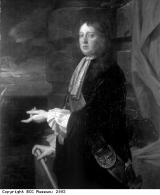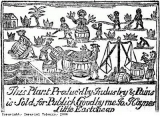The trade with Africa
African goods had been traded in Europe for centuries through Muslim traders in North Africa. European countries began trading directly with Africa in the 15th century. The main goods traded in the early period were gold, ivory, woods (to make dye) and pepper. In the 15th and 16th centuries the buying of enslaved Africans was a small part of the trade with Africa, they were used as domestic servants. There was no great demand for slave labour at that time.
This began to change in the 17th century. Europeans were starting to inhabit, or colonise , the islands of the Caribbean and the mainland of North and South America. Bristol’s Admiral Sir William Penn, as pictured here, took Jamaica from the Spanish who had colonised it previously. British settlers moved to the island. Such newcomers may have started by growing food, but they began to grow ‘cash’ crops to sell. Large estates developed, called ‘plantations’, which were devoted to growing sugar or tobacco for sale to Europe.
These crops, especially sugar, required large numbers of workers. The local population of Amerindians , who were there before the Europeans arrived, were put to work, as well as ‘indentured’ servants from England. Indentured servants agreed to work for a master for a given number of years. They sold their labour in return for their travel costs, food and lodging, and a lump sum at the end of the agreed period. Around 135,000 indentured servants went out to North America and the Caribbean during the 17th century, often because there was no work available at home. Other white servants were prisoners serving out their sentence who were put to work abroad instead of being imprisoned (or hung) at home.
Between the Amerindians and the indentured servants, there were still not enough people to work the land. The plantation owners needed a larger workforce, preferably able to work in the tropical climate, as indentured servants from Europe were not used to it. They also had to be used to agricultural work.
The Portuguese had bought slaves from Africa since the 1440s for their plantations in North and South America and the Caribbean. London and Dutch merchants joined the trade after 1600. Africa was the place to get the new workers for the plantations in the Caribbean. Africans were often used to agricultural work. The existing slave trade could increase to supply the demand. For a time, the white indentured servants and the enslaved Africans worked side by side, as pictured on this business card from a tobacconist in the early 18th century. They can be seen on a plantation in North America picking tobacco leaves and putting them into barrels. However, it was not long before the enslaved Africans became the main workers on the plantations. Not enough white people were coming out to the islands and Africa could provide all the labour that was needed.




